The recent Myanmar Coup is hardly unprecedented. Myanmar was governed by a military dictatorship from 1962 to 2011, leaving the country under the iron fist of the Tatmadaw, the Burmese Military. The strength of the Tatmadaw was enshrined by the 2008 Constitution, which guarantees one third of parliamentary seats to the military, reserves leadership of the Ministries of Home, Defense and Border affairs to military officials, and provides a coup mechanism for the military-dominated National Defense Council to unilaterally seize power in the event of a state of emergency. But if one thing has changed, it is that Myanmar citizens no longer fight alone.
A Tale of Two Resistance Movements
In a stunning display of camaraderie, Myanmar activists have received international support from the 2019 Hong Kong Resistance (HK19) movement through the creation of the HK19 Manual. The HK19 Manual, which can be found here, is currently being circulated as a crowdsourced google document sharing tactics, experiences, and resources from the 2019-2020 Hong Kong protests. The manual is available in both English and Burmese languages, and translators will continue to work on disseminating the manual in several other ethnic dialects. Individual contributors remain anonymous to avoid identification and surveillance.
Like Burmese citizens, Hong Kongers have long engaged in protests for pro-democracy reforms. The watershed 2014 Umbrella Movement was sparked by China’s decision to allow elections in Hong Kong in 2017, but only from a list of candidates pre-approved by the Chinese government. Subsequently, the 2019-2020 protest wave began as a resistance against the controversial Fugitive Amendment Bill that would allow for extradition of Hong Kongers to mainland China and Taiwan, thus subjecting Hong Kong civilians to the legal system of China. The bill radically undermined the promise of One Country, Two Systems — a policy that constitutionally enshrines Hong Kong’s autonomy. While the goal of the Hong Kong Resistance was broadly framed as resistance against Chinese encroachment on Hong Kong sovereignty, strategies quickly grew to lobby for larger democratic reforms that would guarantee a secure, truly representative Hong Kong government — and not a proxy, out-of-touch bureaucracy.
As two aggrieved groups struggling under the weight of repressive governments, both the Hong Kong Resistance and Myanmar Anti-Coup Movement share a collective commitment to establishing civil liberties, political rights and democracy. The recent Myanmar coup took place following the 2020 Myanmar Elections, where the National League for Democracy secured a landslide victory with a two-thirds majority in parliament. Seemingly, there was a real fear that a two-thirds majority would prompt the NLD to alter the 2008 Constitution, which enshrines the Tatmadaw’s powers as the de-facto ruling body of Myanmar.
The nature of the HK19 Manual, which currently remains a google document, epitomizes the shared collective identity of the HK-Myanmar alliance — whereby activists, scholars, and allies can express their solidarity by contributing their knowledge to the collaborative document.
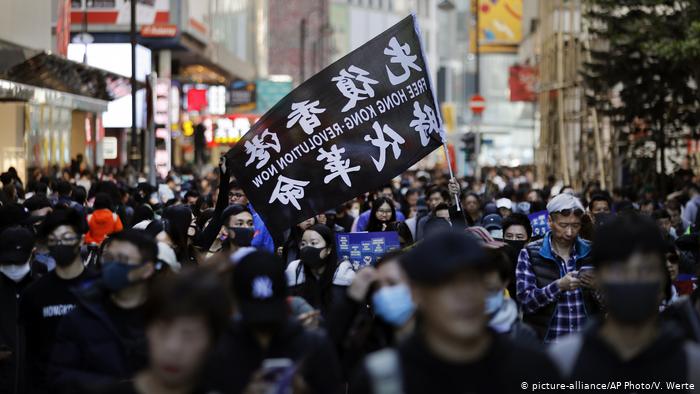
Hong Kong 2019 protesters hold sign reading “Free Hong Kong: Revolution Now”
Solidarity in Resistance – But For What Cause?
The primary goal of Burmese activists is to dismantle the Tatmadaw’s control of the Myanmar government. But, the strategies to achieve this goal widely differ. On one hand, sympathizers of Aung San Suu Kyi and the NLD call for a restoration of democracy, following Myanmar’s upward trend of democratization since the end of formal military rule in 2011. However, many ethnic minorities feel disillusioned by Suu Kyi, who has propagated a pro-Bamar Buddhist stance while being greatly cooperative with the Tatmadaw — even defending the armed forces against international accusations of genocide against the Rohingya Muslims at the International Court of Justice last year. Between 2015 and 2021, the military NLD has done little to disentangle the military’s hold on governing power. For many protesting ethnic minorities, therefore, their strategy does not only concern dismantling the military regime, but establishing a truly federalist democratic union that distributes governing power among all ethno-religious groups in the country. It’s not just about revolution — activists want devolution and durable political change.
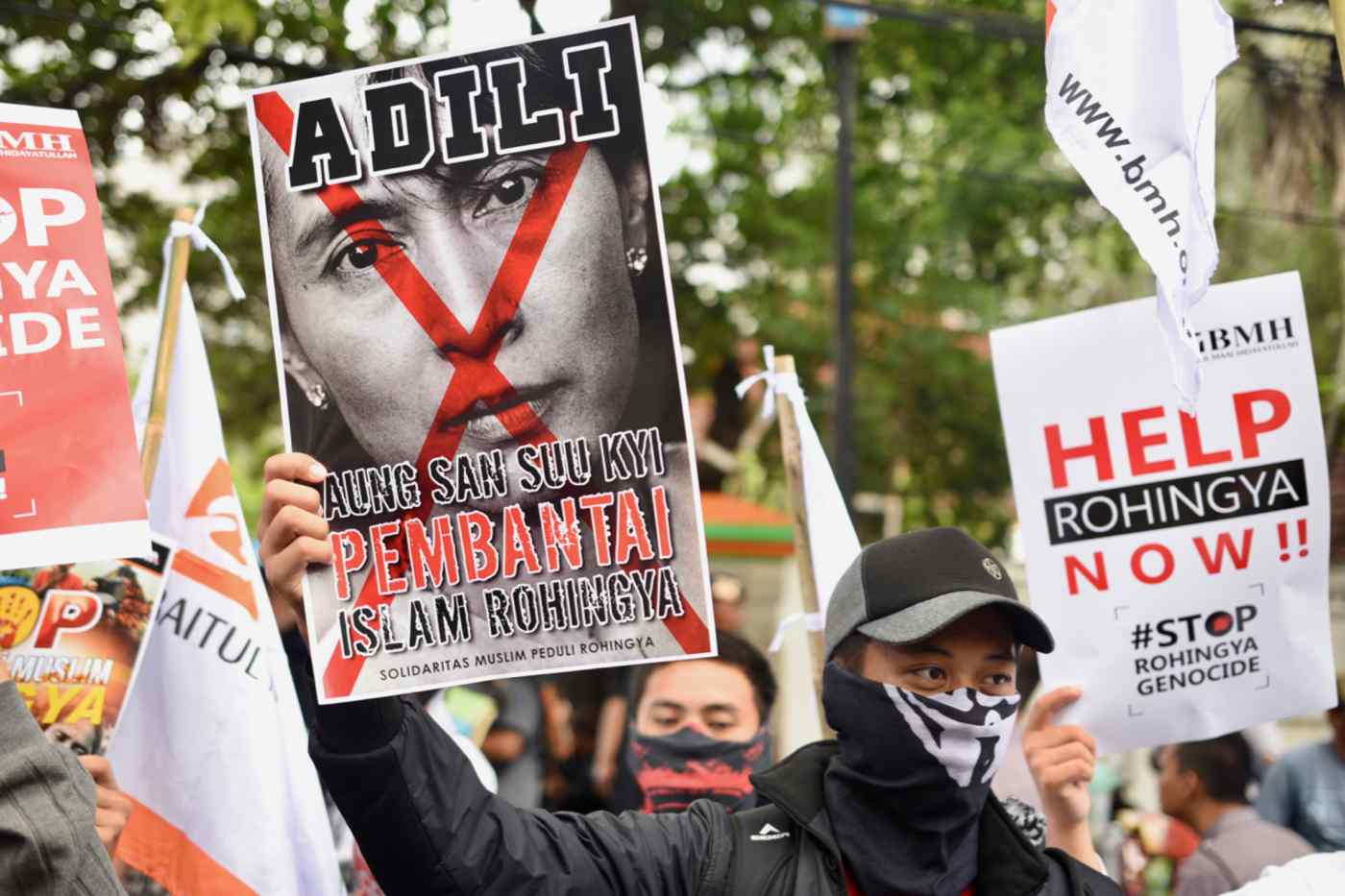
Protester holds sign criticizing Aung San Suu Kyi’s reluctance to address Rohingya human rights abuses in Myanmar’s Rakhine State
Source: Nikkei Asia 2016
Perhaps this explains why HK19 encourages Burmese activists to pursue a leaderless strategy. Without a sole leader, the Hong Kong Resistance was able to 1) remove a point of clear attack by the regime; 2) encourage people with abilities to try things on their own and; 3) actively engage the public in a vision for collective action. HK19 also saw this as a solution to the free-rider problem; activists became their own leaders, and everyone pulled their weight.
Recognizing the fragmented support for Aung San Suu Kyi, as well as her complicated relationship with the armed forces, means that using Suu Kyi as the movement’s leader could actually undermine much of the anti-coup movement’s strategies — particularly for Rohingya minorities, who have faced increasingly hostile, genocidal policies under Suu Kyi’s administration. Suu Kyi was also arrested on the first day of the coup, highlighting how leaders are an easy target for the military regime. A leaderless movement better protects its members, while prioritizing community-building, grassroots organizing, and the voices of the people themselves. For Myanmar, this could be a crucial strategy for bridging divisions between ethnic activists and building a unified resistance.
“History books like to talk about charismatic leaders who inspire a nation, whether in war or peace. They are, in practice, not very helpful”
– HK19
HK19 also warns Myanmar activists about the importance of an effective strategy — one that is specific, precise, and as unified as possible. In an ideal scenario, all participants would agree on diagnostic framing and prognostic framing — that is, locating what the issue is, and how to address it. In reality, there is great variation across strategies. Establishing a clear set of strategies moving forward — indeed, strategies that not only prioritize democratic reforms, but consider active improvements to the conditions of minority rights and representation, will be crucial for forming a united resistance front in Myanmar.
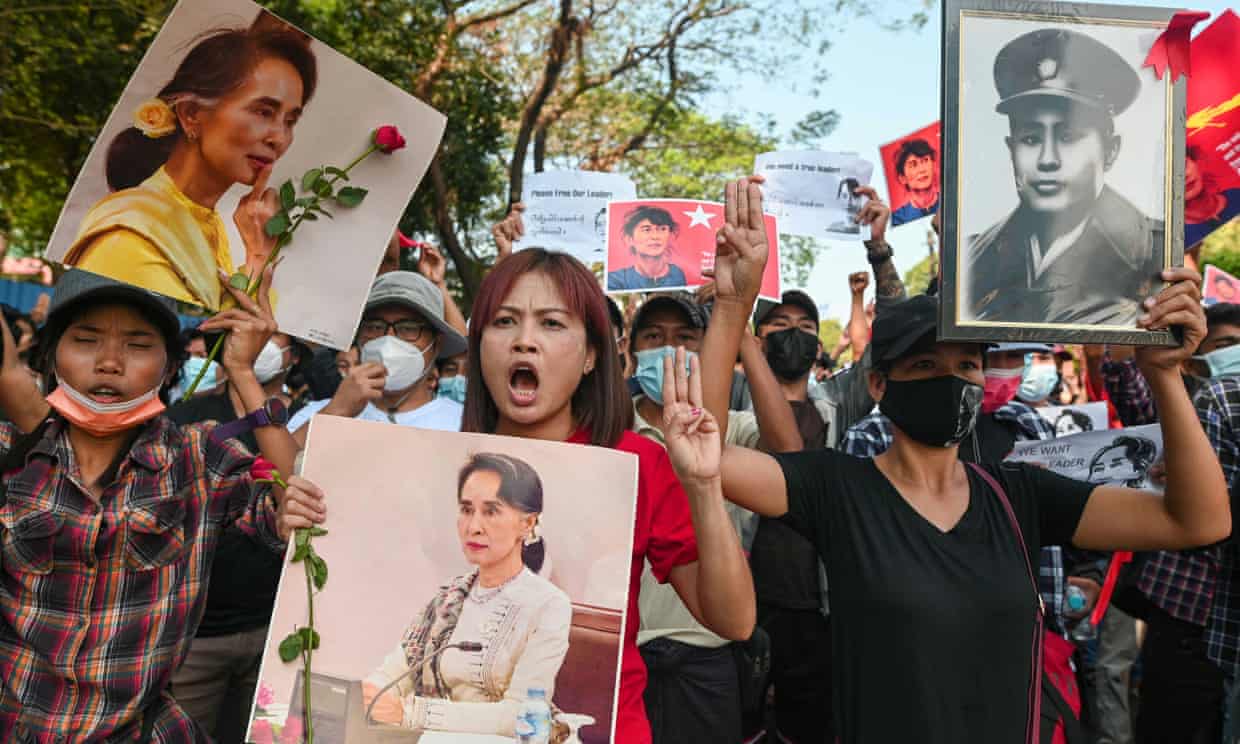
Activists use the 3-finger salute to demand the release of Aung San Suu Kyi
Source: Guardian 2021
Are Violent Tactics The Answer?
Following the repressive security law imposed upon Hong Kongers last year, the momentum of the Hong Kong Resistance is now largely underground. But the wealth of tactical knowledge is not lost — for the HK19 Manual is an enduring repertoire of contention, now available for Burmese activists to dip into whenever the political opportunity arises. The “How Tos” section includes a range of self-defense tactics; during the Umbrella Movement, for example, activists used umbrellas to shield themselves from tear gas and pepper spray. As a result, the HK19 Manual emphasizes the importance of protective gear that will not be easily confiscated or identified by military forces.

Civilians hold yellow umbrellas outside government headquarters to signal passive resistance to the police use of teargas against protesters (2014)
Source: Guardian 2015
In turn, Burmese activists have begun employing hidden transcripts: a protest tactic that appears to abide by the public transcript (that is, the law or normative behaviors under the military regime), while in fact signaling resistance. Protesters have strung up women’s garments in the streets in order to deter military forces, following a popular Burmese superstition that walking beneath women’s clothing is bad luck for men. Even the famous 3-finger salute, now an iconic symbol of Burmese resistance, began as a hidden transcript adopted from the Hunger Games franchise. Presenting as an innocuous appreciation of popular culture, the 3-finger salute was initially unidentifiable to the military regime — until its widespread popularity brought the 3-finger salute into mainstream discourse. As protests continue, we will be sure to see a range of new, imaginative hidden transcripts.
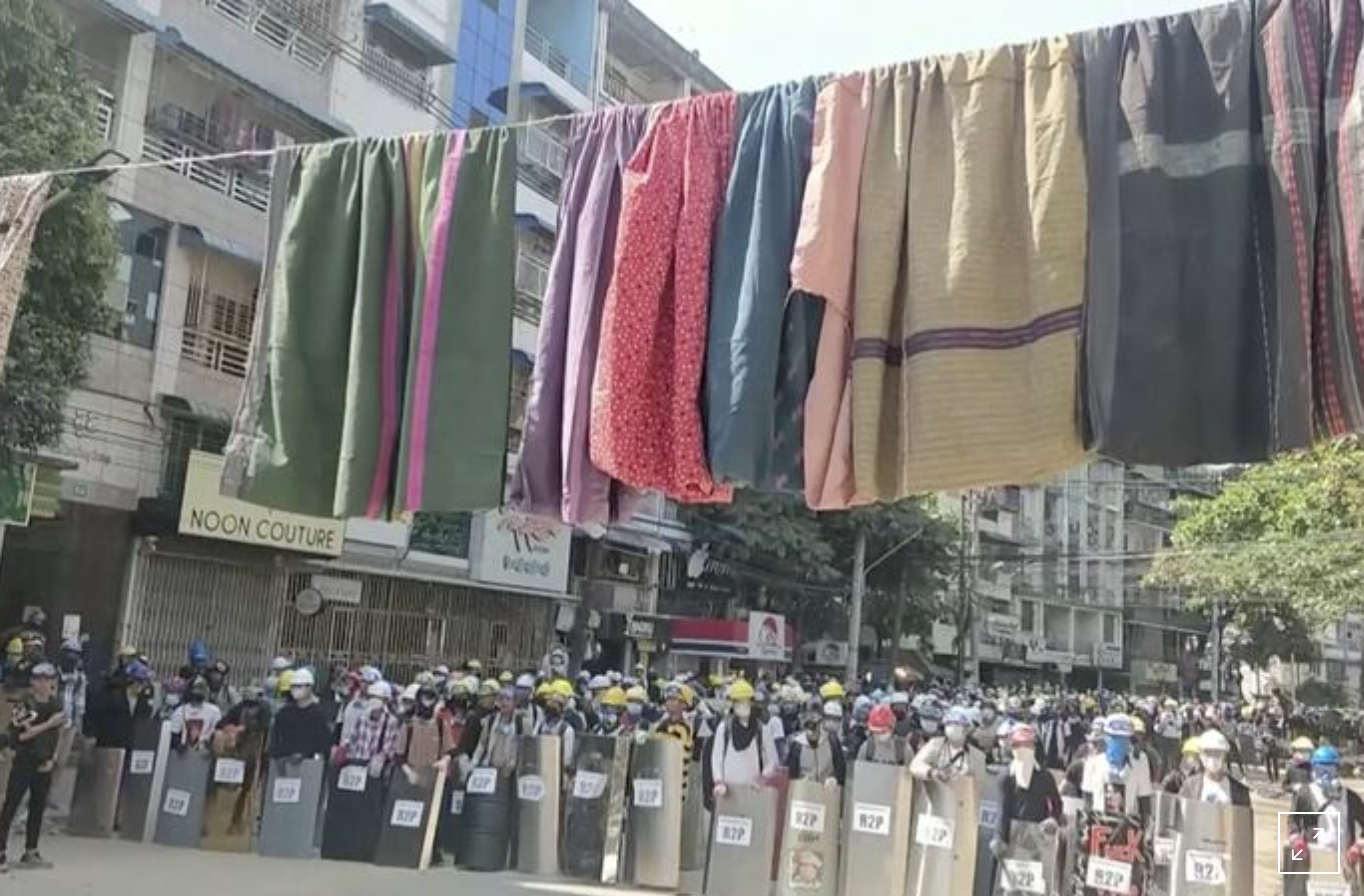
Protesters hang women’s clothing in the streets to obstruct military forces
Source: Reuters 2021
But Burmese civilians experience increasingly bloody retaliations against anti-coup demonstrations, with 100 civilians shot dead by the military junta last weekend. Now, the question for Burmese protesters is whether or not more violent tactics should be deployed. Indeed, if the military is able to exercise unparalleled, disproportionate force against civilians, then why should civilians be expected to use non-violent tactics? Under a law announced on February 15, any participant in the resistance – violent, nonviolent, or a mere bystander – can be subject to up to 20 years in prison if they obstruct the armed forces. Engaging in discontent towards the military “by words, either spoken or written, or by signs, or by visible representation”, are all punishable by fines or imprisonment. When the law itself is immoral and unjust, actions violating said law cannot be considered illegal — rather, any violent action undertaken by Burmese activists should now be considered extralegal protest. It is hardly a just law when the military can exercise unchecked, inhumane force.
Nonetheless, violent protest tactics remain risky under military rule — especially with the threat of the Tatmadaw’s retaliation. Again, HK19 advises Burmese protesters: front-liners cannot simply appear as aggressors, but must appear in solidarity with peaceful, rational, non-violent protesters and take the brunt of police aggression. This was a tactic adopted by the nonviolent resistance front in Hong Kong, which sought to distinguish itself from the brutality of police forces. As Burmese protesters adopt non-violent tactics through mass demonstrations, peaceful protests, and hidden transcripts, activists set themselves apart from the brute force of the Tatmadaw. It also secures a certain longevity for the movement — activists adopt self-defense tactics, rather than aggressive ones, to protect themselves and prevent a total clamp-down from the Tatmadaw.
“A lot of what we’re seeing — the national security law, the increasingly draconian legislation, the distortion of what we used to know — don’t strike me as a signal of strength from the central government. But once you start seeing a social movement as not an explosion, though it initially looks like one, but as a slow burn… the longer we can sustain our unity, the longer we can keep it burning, and the better our chances are…”
– HK19
HK19 notes that the guiding spirit of the Resistance was a desire to “be free of dogma”. hK19 required activists to engage in trial and error, and imagine new tactics. Likewise, what the people of Myanmar are rallying for is not a restoration of some past system, or a return to “normalcy” – they are fighting for something completely new, and therefore must imagine new strategies and tactics to achieve their goal of an end to military rule.
“How would you know something doesn’t work if you don’t try? We tried many crazy things. Most were just crazy :)”
– HK19
What Next?
Popular discourse renders the Hong Kong Resistance dead and failed — but the HK19 Manual clearly depicts otherwise. While the outcome may not have been the desired policy change , HK19 activists have undergone a radical internal change by recognizing their own connections to global cases of contentious collective action. A cultural change is also being set into motion, in which we see an unprecedented transnational solidarity between HK19 and Burmese activists.
Already, there is widespread discursive change surrounding the Myanmar resistance. This is far from the country’s first run-in with the military government – the sweeping 8888 Uprisings in March 1988 were the first mass demonstrations opposing the brutal 26-year-long military dictatorship under General Ne Win. In 2007, the Sangha (Buddhist clergy) spearheaded a campaign against state repression, government corruption and mismanagement of state resources through the Saffron Revolution . Fast-forward to 2021, and the dominant framing no longer depicts Myanmar’s internal struggles as isolated incidents of civil dissent, but rather, a longstanding narrative of military repression. Widespread coverage of the coup on social media and international news platforms signals a newfound consciousness-raising, whereby the Myanmar issue is now salient on the international agenda. And solutions are no longer framed as relying on a single leader or party to liberate Myanmar — rather, the movement draws its strength from its leaderless, communal roots.
“The Hows are hard-won. None of us knew what we were doing, and we made mistakes and took many false turns”
– HK19
As international allies, the HK19 Manual outlines various ways for us to assist core activists in Myanmar. Using transnational advocacy networks, we can lobby for policy change via NGOs and local organizations, or simply contribute to information sharing via social media, art, and publicity. Ensuring that information is spread, and not repressed, is a crucial way to be an ally at this time.
The HK19 Manual is a testament to the resilience of social movements. When the HK19 Resistance was squashed, activists did not abandon their goals, but instead emerged as allies to Myanmar. When the Tatmadaw imposed a social media ban, activists found new ways to crowdsource resources and maintain communication. Now, with the knowledge of the HK19 Manual, the work begins for Myanmar activists and allies who must imagine new ways to advocate for democracy and human rights.
The story of collective action in Myanmar is not all doom. There is great power in building transnational networks of solidarity. It tells us that the narrative of resistance in Myanmar is far from over — that there is much to learn from, and much to look towards.
Featured Image Source: BBC 2021
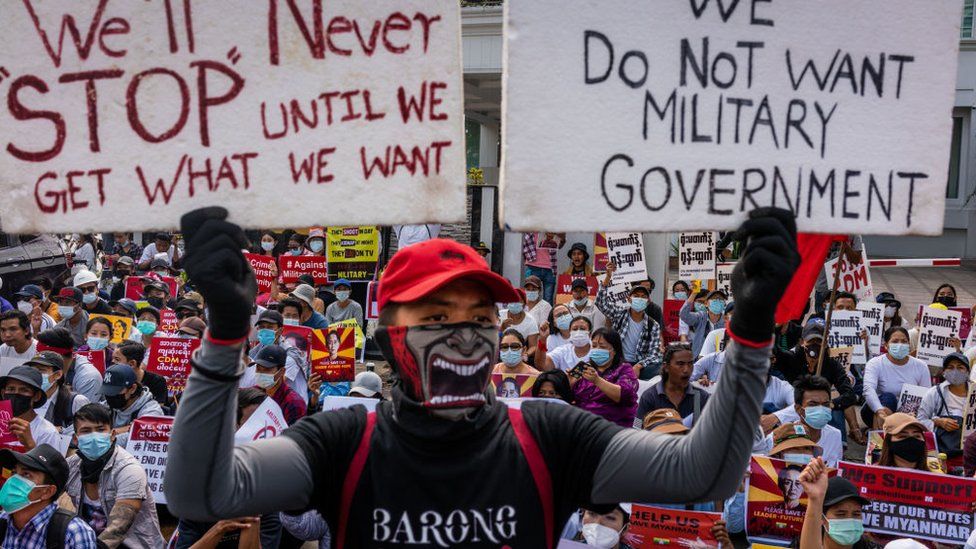





Comments are closed.